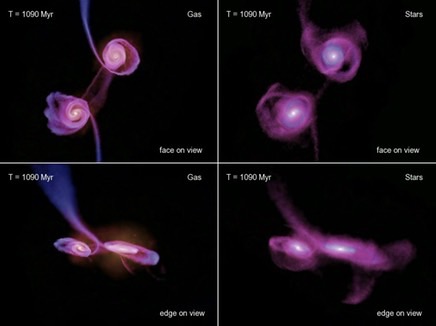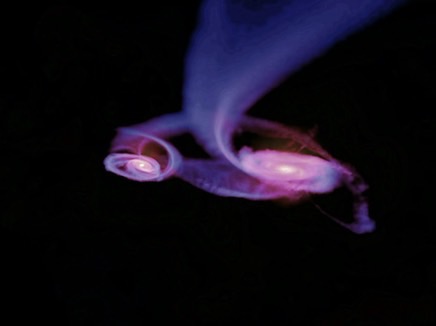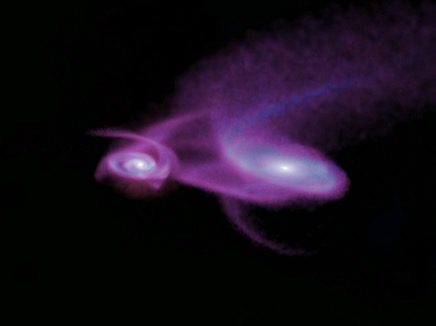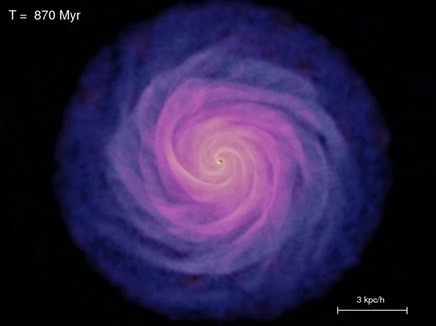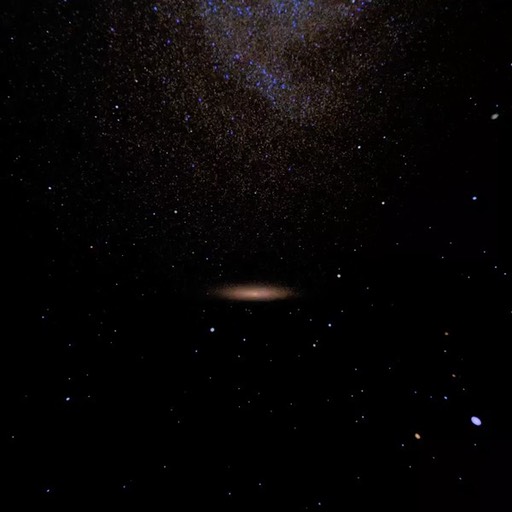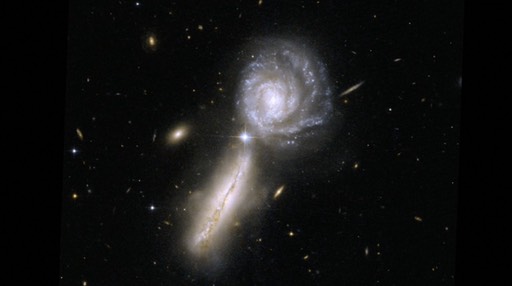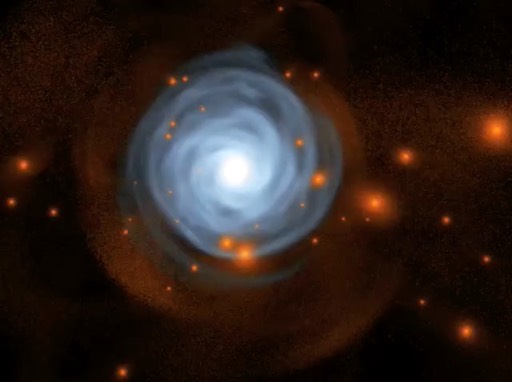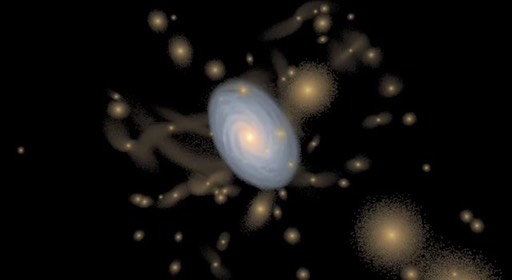These movies show typical simulations of major galaxy mergers. In the mergers, two Milky Way-like disk galaxies with a 2:1 mass ratio are placed in an initial parabolic orbit. The disks are constructed in equilibrium, with properties corresponding to observed disk galaxies, and include stellar and gas disks, central spheroidal bulges, and black holes, within a dark matter halo. As the halos orbit, the galaxies lose angular momentum to the dark matter via dynamical friction and sink to the center. Upon “first passage”, torques exerted by the systems drive gas to the centers of each galaxy, which in turn begins to feed black hole growth and central star formation. The large gas densities and small relative size of the black hole ensure it remains shrouded in gas and dust, as a classical “ULIRG.” This builds up and the starburst eventually peaks as the galaxies coalesce. The black holes of both galaxies rapidly sink to the center of the galaxy and merge, growing until, shortly after the final coalescence, the black hole is sufficiently massive and luminous that the coupling of even a small fraction of the radiated accretion energy to the surrounding gas rapidly unbinds and heats that gas. The small amount of remaining cold gas is driven out in an explosive, quasar-driven wind, leaving a black hole that obeys observed correlations between black hole and host galaxy mass. With star formation effectively terminated, the remnant then gradually relaxes and its colors redden, as it evolves to resemble a typical, local massive elliptical galaxy.
These simulations did not resolve the parsec-scale structure of the interstellar medium and effects of feedback from massive stars (radiation pressure, supernovae, photoionization heating, and stellar winds) on the ISM. To see how these can -- sometimes dramatically -- change these dynamics in galaxy mergers, click here.
Collision: Gas and Stars
This shows gas (first) and stars (second) in the merger, then both at the same time in a multi-panel view from two different viewing angles. Gas: color shows gas temperature from 1e4 K (blue) to 1e6 K (red). Stars: color shows mean stellar age, from 1e7 yr (blue) to 1e9 yr (red). Brightness shows projected surface density, scaled logarithmically. Credit: Volker Springel
Collision: Gas
Gas: color shows gas temperature from 1e4 K (blue) to 1e6 K (red). Brightness shows projected surface density, scaled logarithmically. Credit: Volker Springel
Collision: Stars
Stars: color shows mean stellar age, from 1e7 yr (blue) to 1e9 yr (red). Brightness shows projected surface density, scaled logarithmically. Credit: Volker Springel
Non-merging Disk
This shows the gas in a single disk, similar to those merging together in the other movies. Color shows gas temperature from 1e4 K (blue) to 1e6 K (red). Brightness shows projected surface density, scaled logarithmically. Credit: Volker Springel
Merger through SUNRISE eyes
This shows a mock 3-color image of the starlight in this merger (similar to the others in this folder), processed through observed filters with the SUNRISE radiative transfer code. Credit: Patrick Jonsson
Sims versus Observations
This shows a merger simulation (stars shown in projected surface density), but maps back and forth between this and real observed merging galaxies. Credit: Frank Summers
Minor mergers
This shows a Milky-Way like galaxy being bombarded by a series of “minor” mergers of small galaxies, falling onto the primary. Each small galaxy is here modeled with just a dark matter halo (orange), while we see the behavior of the main galaxy stars.
More minor mergers
This shows a Milky-Way like galaxy being bombarded by a series of “minor” mergers of small galaxies, falling onto the primary. Each small galaxy is here modeled with a sphere of particles which leave streams as they are tidally disrupted.
